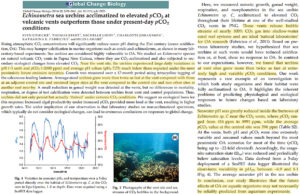by K. Richard, June 29, 2020 in NoTricksZone
Marine species subjected to high CO2 extremes – 8,891 to 95,000 ppm – in their natural environments may not be adversely affected. They may even “thrive”.
Earlier this year we highlighted a study that says coral reefs “thrive” near seafloor volcanic vents where CO2 concentrations reach 60,000 to 95,000 ppm.
Urchins basking in volcanic vent streams of 8,891 ppm CO2 and daily CO2 variations of more than 2,000 ppm as well as day-to-day pH fluctuations ranging from 6.9 (“acidification”) to 8.1…grow more than two times faster than nearby control (stable 394 ppm CO2, 8.1 pH) urchins (Uthicke et al., 2016).

…
